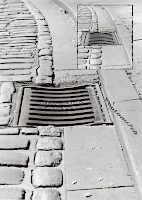 I am no
stranger to making up developers from powders into stock solutions. The first thing you notice is the
very small amount it makes up. Next, it comes in two parts and last, the powder
needs to be mixed into distilled/de-ionised water ( used for car battery top
ups ).
I am no
stranger to making up developers from powders into stock solutions. The first thing you notice is the
very small amount it makes up. Next, it comes in two parts and last, the powder
needs to be mixed into distilled/de-ionised water ( used for car battery top
ups ).
Solution
A mixes up as
follows:
Pour 80 mls
of de-ionised water at room temperature into a measure. Open the packet marked A inside there are two sachets, take the smaller
one and mix that in until it dissolves, do the same with the second one. It is
important that they go in, in the right order. Make the solution up to a 1oo
mls once done pour into a small storage container.
Solution
B
Pour 160 mls
of de-ionised water at room temperature into a measure. Add the contents of
packet B slowly to the water stirring all the
time until dissolved. Then top up to 200 mls. Again pour into small storage
container.
Some
notes:
By the time
all the powders are mixed in, the amount of top up will be very small. The
distilled/de-ionised water helps it to stay fresh and will keep well in partly
filled bottles. Solution B has a bit of drop out and will need to be shaken clear
before use. Makes up to 10 litres of working developer.
 |
| Freshly made PMK Pyro |
Making
up a working solution:
A normal mix
is as follows,
•
One
part A + two parts B to One hundred part of water.
e.g: To make
600 mls of working developer. Measure out 500 mls of water add 6 mls of
solution A then add 12 mls of solution B and top off to 600 mls and stir. It is
important that they go in in this order.
Notes:
•
When
you add part B to the water it will turn a straw colour,
if this happens it's OK to use.
•
Working
temperature should be 20- 21 degrees C depending on which make of film you are
using. You can check this with Digital truths
massive dev chart.
 |
Used PMK Pyro
developer.You reuse this at the
end of the process to add extra
stain to the negatives. |
•
Prepare
everything else before you make up the working developer then use it straight
away as it oxidises very quickly.
•
When
you pour the developer out at the end of the allotted time the solution will be
very dark brown.
•
It
is a 'use once and throw away' developer.
•
It
is not necessary to re-dip the film in the developer after it has been fixed to
increase staining.
•
Make
working solution up with filtered tap water.




























